Tokenization of Securities
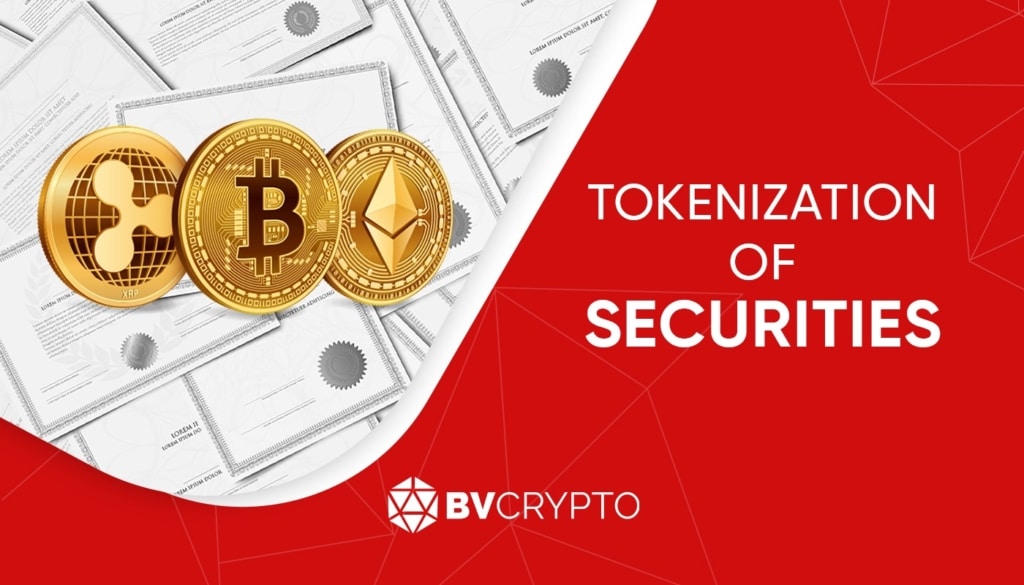
The process that initiated with cryptocurrencies’ step-by-step transformation of the entire workings of finance and the tokenization of all tangible or intangible asset-backed financial products has begun to attract the attention of regulators with the tokenization of securities. It seems that the entire cryptocurrency sector is in trouble with regulators in this context, starting with the prominent cryptocurrency exchange Binance. We can begin to answer the question ‘Why now?’ by considering how securities are currently in very frequent use and constitute a range of products that traditional finance regulates in every country. The tokenization of a product quite well-known by regulators perhaps led to the emergence of a field where regulators have the clearest information in the entire cryptocurrency field and can offer their verdicts on what can and cannot be done. It would also be correct to say that after these developments, the cryptocurrency sector has no intention to give up on the tokenization trend either. This movement that occurs especially through decentralised platforms and synthetic token products is quite important for the cryptocurrency market to incorporate traditional financial products. It seems that until the decentralised infrastructure of tokenization is ensured, the problems the cryptocurrency market faces due to the regulators will not subside. In order to explain the current situation in detail, we can list the topics discussed in this article as follows:
- Types of securities
- Tokenization process of securities and decoupling between traditional securities and tokenized securities
- An investigation of which countries (in Europe, the US, and in the Asia-Pacific region) have what kinds of regulations regarding the tokenization of securities
- An overview of the problems and dilemmas that face the sector on the issue of securities
We have shared with you our short and explanatory comments on each of the above subjects in the article. We wish you pleasant reading.
Types of Securities
Before considering the problems and details of securities, let us first take a look at the types of securities that undergo tokenization.
1. Securities That Represent Dividend Rights
This is the system where the company that issues the security pays the owners of the token on the basis of the profit the company obtains. Investors have the right to have a share of the company’s profit, with their share being determined by the number of tokens they own. It is quite important that the company is trustworthy and complies with the regulations. Because companies may announce profit rates that are lower than the actual profit rates by altering their accounting records. Therefore, the trust in the company is relatively more important in this type of token for the emergence of investor demand.
2. Securities That Represent Income Share Rights
Similar to article one, investors generate an income through the tokens they own. However, the gains here are calculated not based on the profit amount of the company but directly on its income.
3. Securities That Represent Income Share Rights of a Product/Service
This method, which is generally used in the early funding of companies, refers to the fundraising of a company, which aims to offer a product or service from investors, before the offering of this product or service. Investors gain the right to use this service through the tokens they own once the service the company undertakes to provide is launched. For instance, a mining company may raise funds from investors in its early phase and may offer a share from its mining income to token owners once the devices begin working.
4. Securities That Indicate Ownership
These are securities that indicate the direct ownership of any intangible or tangible asset. For instance, you may create a token for a house you own and sell this to another person, therefore selling your house through such a securities token. The token in this example directly refers to the ownership right to that house.
5. The Second Type of Securities That Provide Passive Income
These security tokens represent the passive income right on the asset they represent, similar to interest. Owners of this token do not generally own the asset the token represents but have the right to have income from that asset. These owners of the second type of tokens can only receive payments after the payments to owners of the first type of tokens are completed. They do not have any right to resort to any sanctions against the company should the latter fail. For instance, let us suppose that a company has created many tokens that function as stock and sell these to investors. Let us further suppose that the same company has created and sold a second token with the promise of regular payments. The owners of the first tokens the company created would then be owners of a token of the first type, the type of tokens discussed in the previous article. The ones who bought the second token would instead be buying the second type of token, which is the subject of this article. In addition, secondary tokens may be quite flexible. For instance, let us suppose that a company that produces steel sells a token of the second type to investors. The income of the company would highly depend on the price of steel. Therefore, the company may base the payments to token owners on the price of steel. For instance, when the price of steel decreases, the company may increase the payment it offers to token owners to receive more demand and it may sell its tokens to compensate for the loss of income. On the contrary, when the price of steel increases, the company may decrease the amount of payment to decrease investor demand.
6. Securities That Represent Companies Established for Special Purposes
Known as Special Purpose Vehicle (SPV), these security tokens are the tokens of subsidiary companies established for special purposes. Subsidiary companies established for special purposes aim to shoulder the risk of risky investments by large companies so that the repercussions of the risk do not reflect on the balance sheets of the main company. However, the problem with such companies is that their incomes depend almost entirely on the main company. If the financial situation of the main company worsens, the owners of the subsidiary company’s token may not receive payment.
7. Securities That Represent Shares of Privately Held Companies
These are the security tokens offered by non-public companies with a special status in exchange for the funds collected from investors.
8. Securities That Represent Shares of Public Companies
Security tokens that represent shares of public companies actually refer to the transfer of the kind of stocks a company already has in the stock exchange to the cryptocurrency market. In this way, companies may reach various customers from a number of markets and raise more funds more quickly.
The tokenization Process and Differences Between Traditional and Tokenised Securities
Various security types discussed above become operationally complete as a result of a process divided into many different steps such as creation, distribution, and buying and selling. Let us review both the differences between traditional and tokenised securities and the general process by looking at these processes.
- Creation Process
Due to regulations to be discussed later in this article, securities are created via investment banks and offered to investors through intermediary financial institutions. However, in the tokenization process, the factor of disintermediation, one of the most well-known advantages of blockchain technology, becomes the key element. The security to be tokenised may be created either directly via platforms established to create tokens or by the software developers of the company that creates the security. For this, it is not necessary that institutions such as investment banks partake in the process. Tokens that represent securities can be offered to investors by defining the rules which apply to the security into smart contracts, and the contractual requirements that apply to the security can be fulfilled by smart contracts automatically and transparently. Therefore, for the offering of a security to investors, there is no need for any intermediary financial institutions. Disintermediation significantly reduces the creation and marketing costs of the security. This is why it can be possible to further reduce the minimum amount the investors who will buy the security must pay.
- Buying-Selling Process
In the traditional method, the intermediary financial institutions mentioned in the previous article also participate in the buying and selling of these securities. These intermediary platforms and institutions ensure the buying and selling of the security and at the same time check whether the company that issues the security and the investor fulfil their responsibilities. In a sense, the intermediary institution functions as a regulatory mechanism and ensures that the trade takes place correctly. Intermediary institutions may be active in transactions with tokenized securities as well. However, this process is rendered unnecessary in security tokens based on smart contracts. Because the responsibilities of both the company that issues the security and the investor are defined into the smart contract and the accounting of all transactions can take place easily through blockchain. Hence, this eliminates the need for an added control mechanism. Despite this, the requirements demanded by each country vary and some of these cannot be defined into smart contracts. In such cases, companies may adopt a hybrid method and make use of both intermediary institutions and smart contracts.
Separately from all these articles, intermediary institutions offer their services during certain working hours. Thanks to blockchain, hour and day limitations are eliminated as well.
In the traditional process, an investor that owns some given securities may transfer these to another person or use them in any financial transaction. However, the various paperwork needed in such cases is both quite primitive by the standards of our time and prolongs the process. The direct transfer of the token from one user to another (P2P) or selling it to another user in an exchange are very simple and quick transactions. This means investors can easily transfer their responsibilities to another user. The company that issues the security does not experience any confusion as to whom it shall make the payment. Payments are made directly to the wallets where the token is kept. Moreover, if the token type is eligible, security tokens may be pledged as collateral to receive loans from DeFi platforms. The traditional methods include all these processes but perform them with a much more cumbersome operational model where fax machines are used.
- Additional After-sales Banking Services
In the traditional process, investors can store the security they bought in the bank or intermediary financial institution through which they performed the transaction. If they wish, they may transfer it to another financial institution to store tokens there. A third option is to demand this security in print and physically store it. Tokenized securities can be easily kept in blockchain wallets that support the token type; thus, investors need not trust a third party for storing their securities. Moreover, this may also mean you have to spend less for the commission rate to be paid for the service of storing securities. Therefore, investors can store their securities safely by themselves. However, regarding regulations, blockchain wallets may not always be available. For instance, if not registered in the taxation system, the security may have to be stored within the intermediary institution. Considering that banks have begun to offer cryptocurrency storing services lately, it is by now possible and quite common to store security tokens as tokens in banks.
In addition to banking services, it is quite important that tokenised securities receive ratings from rating agencies. As for trust in the tokenization process, which is quite new for investors outside the crypto market, the ratings given to token standards of the company that issues the security will ensure that investors outside the crypto market will have trust in the company. Mitsui Trust Bank, headquartered in Japan and Societe Generale, headquartered in France are the pioneering institutions that offer such ranking services.
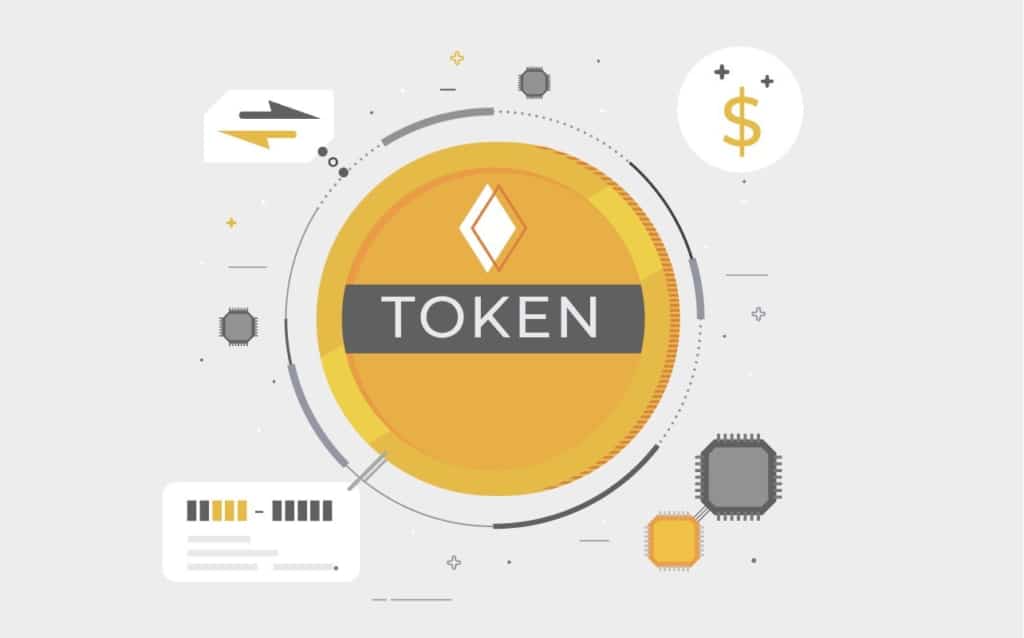
Technical Requirements
There are certain conditions companies that wish to issue securities in the form of tokens must consider due to regulations. Due to the nature of blockchain, it may be impossible to meet all the requirements. Therefore, companies are often obliged to use hybrid models.
1. It is one of the conditions required to integrate the terms related to who the securities token will be sold to and to whom it can be transferred. In this way, the company wishes to ensure that only investors that have the meet the required conditions have the security. However, it may, of course, not always be possible to block these transfers in P2P (peer to peer) and buys and sales in cryptocurrency exchanges. Therefore, having a centralized blockchain network to which the token will be issued might be more beneficial for the realisation of this article.
As a remedy to this situation, companies offer their tokens to be issued for pre-sales, examine the investors and compose a list called whitelist where certain investors are selected. In this way, not all investors that demand it can buy the token but only the ones chosen by the company. That said, sales of these tokens in the free market may give rise to various problems.
2. Another condition is the rates of commission being low. An important characteristic of blockchain technology is disintermediation; thus it is necessary not to use this cost advantage through fees during the creation or transferring of tokens.
3. A further condition is that the company that issues the security must command the token even after the selling of the token. This is not limited to determining to whom investors can transfer the token as in the first article but also includes the possibility that an investor previously selected and deemed eligible no longer meets the requirements or gets involved with criminal activities. For such cases, companies’ criteria include control mechanisms such as blocking of the account where the token is kept, blacklisting of such accounts, the freezing of payments to the owner of the token.
4. In addition to the three control-oriented approaches in the three articles above, the network where transactions involving the security token will occur must be as accessible and eligible for common use as possible. This is important to ensure liquidity and to make sure that the company can reach more investors and make the most out of the offers provided by different platforms.
It is fairly difficult to find a token standard that will completely fulfil all these criteria which we have roughly summarised with the four articles above. The advantage that comes from one article may not be found in another. Therefore, even though the tokenization process provides great advantages, the lack of updates in the regulations and the lack of maturity in the diversity of tokens and smart contracts in this field as of now are among the factors that hinder the process. Despite this, there are several token standards and infrastructure used for tokenized securities.
Token Standards and Infrastructure
- ERC-20 and ERC-1400
The ERC-20 token standard is a standard used by nearly all tokens active on the Ethereum network. However, in this token standard, it is not possible to include know-your-customer (KYC) or anti-money laundering (AML) data. ERC-1400 is a token standard that provides the right infrastructure for allowing KYC and AML data. Yet, as Ethereum is a decentralised network, even though it can address the need for common use discussed in the fourth article, it is not a blockchain network suitable for precise control mechanisms on tokens.
- DS Protocol
This protocol, created especially for securities, complies with the regulations.
- R-Token
We can define R-Token as a version of the ERC-20 token standard to which KYC, AML and tax regulations can be added. Moreover, it grants token creators flexibility so that they can make certain changes to the token.
- Tezos
The Tezos blockchain network allows security tokens to be tested off-chain before becoming on-chain and the integration of KYC-AML regulation into the token.
- Hyperledger
Hyperledger, which is a blockchain platform owned by Linux, is a flexible structure that allows interchain transfers through the FabToken protocol and further allows users to design their tokens in accordance with the regulatory requirements.
- tZERO
tZERO is a platform registered to FINRA and SEC that complies with the regulations and offers services for both the tokenization and buying and selling processes.
- Cat-20 / Cat-721
These two products of Securrency allow companies that want to create tokens to choose one of the following networks: Ethereum-EOS-Ripple-GoChain-Stellar. Users can also perform cross chain transfers and integrate KYC-AML obligations into the token.
- St20 V1/V2
St20 V1/V2 is a security tokenization standard that works on Polymath’s own blockchain network. It is based on ERC-20 standards. However, it provides flexibility to token creators for token privatisation and regulatory additions.
- SRC-20
This platform, supported by Swarm, allows tokenization of various products.
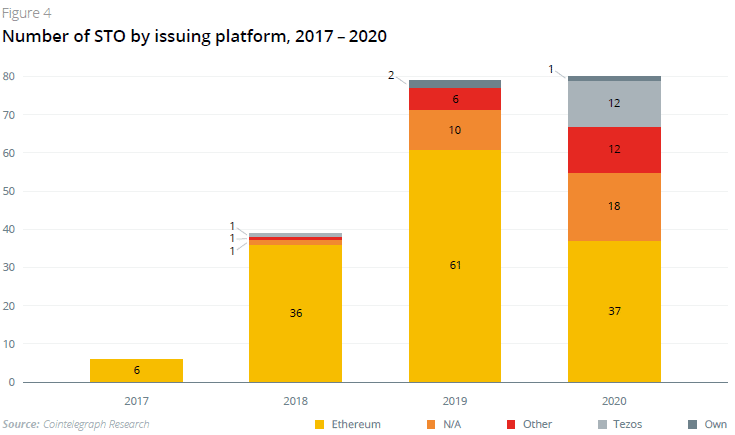
To examine which security tokens issued between 2017 and 2020 used which blockchain networks, see the graph above. Though the Ethereum network (in yellow) had a quite clear superiority, it seems that in 2020, Tezos and private blockchain networks stole a considerable part of Ethereum’s share. One potential reason for the sudden rise of Tezos is its KYC-AML-compatible token standard while another such reason is the finalisation in September 2020 of the lawsuit concerning the fundraising by Tezos in 2017. With the finalisation of the lawsuit, the dark clouds hovering above Tezos were dispersed.
To summarise the information provided thus far, we have seen that security tokenization provides very clear advantages to both the issuing company and the investor. We have also seen the advent of services offering solutions for tokenization operations in the crypto market through various token standards and platforms. The process of innovation embodied by cryptocurrencies continues its impressive expansion to transform all sectors with cumbersome operational models involving fax machines and various paperwork. The greatest innovation by cryptocurrencies is the ability to securely perform financial transactions without any need for monitoring by a third party or trust between the buyer and seller. Similarly, in security tokenization, the reason that the creators of securities are investment banks and that certain intermediary institutions run the operational process is that the company that wishes to issue the security wants to utilise the trust and the customer base these financial institutions have. As there are no trust issues on blockchain, it suffices to review the token’s standards alone. We can liken this transformation to smartphones, in a way. Many applications on smartphones allow users to control everything from one device. Before smartphones, to listen to music, for instance, individuals needed mp3 players. Similarly, in our case,
the whole process can be performed on blockchain instead of receiving services from different institutions in every single transaction to ensure security. As for the customer base, the attractiveness of cryptocurrency platforms keeps increasing. This is because both, speaking quantitatively, increasingly more people rush into these platforms and because securities offered specifically to professional investors can now be tokenized thanks to the interest from institutional investors which has peaked in 2021. Because in an environment without institutional investors, it might be difficult to find professional investors. Though not difficult, in such a case there would be no reason for companies that find investors through the traditional system to turn to the tokenization method. Thus, the entry of institutional investors into the cryptocurrency market may lead to the issuing of large-scale securities that target professional investors to opt for tokenization. The sector’s maturation or, in other words, the abundance of liquidity makes the cryptocurrency market attractive.
Regulations
Despite all the positive processes indicated above about tokenization, it is indispensable for the spread of tokenization that countries update their regulatory infrastructure in this field. Let us review regulatory processes under the categories of the US, Europe and the Asia-Pacific region.
The US
It is necessary to approach this issue in the US from two perspectives. SEC, the regulatory authority for securities, checks the adequacy of tokens in cases where known securities are tokenized, while it emphasises the concept of the investment contract in cases involving types of securities that do not exist in the traditional market. According to laws of the US, an investment contract is defined as ‘contract, transaction, or scheme whereby a person invests money (or, in later interpretations, anything else of value), in a common enterprise, and is led to expect profits, solely (or, in later interpretations, predominantly) from the efforts of others’. SEC examines whether new security tokens fall under investment contracts. However, an important problem arises here. As cryptocurrencies are programmable products, a token created for a given purpose may later have a different function. For instance, a security token may initially be sold for fundraising purposes. However, this token may later be used for the service offered by the platform or directly for the management of the platform. In such a case, the token may no longer count as security and fall under a different definition. The dynamic nature of cryptocurrencies tops the list of the most difficult problems for regulators. Traditional financial products often do not provide any additional gains besides their purpose of issuing. But cryptocurrencies as programmable currencies are much more flexible and, therefore, much more difficult to regulate. Due to such problems, SEC takes a lot of time to make decisions on cryptocurrencies, which often end up being negative. However, if a token is deemed adequate for SEC and receives the status of security, the token can easily appear in transactions in compliance with current directives concerning securities.
Bill Hinman, a director at SEC, offered a solution proposal for security tokens by stating that two main assessment standards must be identified for these tokens. These standards would see that tokens that acquire a certain degree of decentralized or tokens that would definitively be used only for the buying of a given service would be assessed independently of directives concerning securities.
In conclusion, since this proposal or any other similar ones are yet to be accepted, the difficult process and dilemmas surrounding SEC’s security classification on cryptocurrencies continue. The result of the currently ongoing Ripple lawsuit may engender important changes in SEC’s approach to the issue.
Europe
Europe is far ahead of the US in terms of regulation. The decisions of especially Switzerland, France, Germany, Luxembourg and the EU Commission are noteworthy.
- Switzerland is the European country that has recorded the greatest progress in the field of regulating securities. The law on tokenization of securities prepared specifically for DLT-based products came into force on the 1st of August 2021. A licensing process wherein minimum requirements are examined for the markets where these tokens will be bought and sold has begun. Through this, it is aimed to prevent any entrepreneur who wishes to do so to establish an exchange.
- The EU Commission has introduced certain standards regarding security tokens and clear regulations for which directives will bind these tokens but has left it to the national jurisdiction of member countries to decide which tokens can and cannot be created. The Commission adopts a wait-and-see policy regarding markets where tokens are bought and sold. Though a license has been created for exchanges that will be active in this field, it is not compulsory for exchanges to obtain this license. However, these exchanges are required to regularly report to European Securities and Markets Authority (ESMA). It has been decided that the ESMA shall present the data and documents it collects at the end of a five-year period to the EU Commission and comprehensive regulations shall be introduced following this presentation.
- France has introduced certain regulations concerning both security tokens, the wallets of these tokens and the standards of the markets where these tokens will be sold. That is, France has set forth both the financial and technical requirements. With her cryptocurrency-related work, France attracts attention also for her being a pioneering country in Europe in the field of CBDC.
- In Germany, security tokens have come under regulation with the enactment of the Electronic Securities Act. However, it is expected that the status of security tokens that are legally considered to be ‘goods’ will be updated with the granting of permission to invest in cryptocurrencies to institutional investors in the country.
- Luxembourg has enacted a law on the regulation of security tokenization with a decision in January 2021.
The Asia-Pacific Region
The digital transformation processes in the Asia-Pacific countries far outpace those in other continents. The populations being large and the country cultures’ being meshed with digital culture (for instance, anime and manga characters and games based on these characters) allow countries in the Asia-Pacific region to become leaders in digital transformation. Some of these countries are also the pioneers of regulation.
- Hong Kong and Taiwan recognise security tokens as legal but require the trade of such tokens to be performed only by professional investors. It is aimed that in this way, citizens will not be affected by the risks of cryptocurrencies.
- Japan allows security tokens in cases where certain standards are met.
- The financial centre of Malaysia, Labuan already has comprehensive regulations in this field.
- Thailand has completed the process of regulation in 2018.
- Singapore is a pioneering country in not only regulating securities but regulating the entire cryptocurrency sector.
- China persists with its prohibitive stance on cryptocurrencies in the field of securities as well.
Institutional entrepreneurs are also noteworthy in the Asia-Pacific region. For instance, the Commonwealth Bank of Australia has been considered a leading entrepreneur in this field. Further examples are companies like Nomura, SBI Securities, Rakuten, and Daiwa Securities in Japan.

The table above classifies traditional and cryptocurrency companies that offer services in different steps of tokenization. Binance can be ignored as it gives signals of retreating from this field following harsh warnings from the regulators of several countries. The initiation of the subsidiary companies of traditional companies and banks to offering tokenization services as a result of regulations introduced by countries has increased expectations on securities. Currently representing a quite large market, securities are expected to grow even further with tokenization and this has started a race between companies. Severe sanctions on some cryptocurrency companies like Binance in recent weeks especially in the field of securities demonstrate that regulators do not want to lose control over the securities sector. Hence, we can predict that to ensure their authority and directives, regulators give primacy to the companies and banks with which they already work in the current system. Cryptocurrency companies do not completely fall under the authority of regulators in the field of securities. Thanks to decentralized platforms and alternative solutions like Synthetix, these can bypass the regulators and create their markets through such synthetic products. However, in such cases, it is highly likely that their competitive power will significantly decrease. It is also quite probable that banks and intermediary financial institutions that integrate the advantages of tokenization into their infrastructure will receive interest and preserve their customer bases more than a platform that will only reach out to the cryptocurrency community.
The role banks can play in securities tokenization is evaluated in two main scenarios:
- Banks can serve as market makers for security tokens. Just as a bank customer can buy stocks or other goods like oil or gold from and sell to bank, banks can position themselves as the final buyer and seller in a similar way. In such a case, banks may themselves determine price spread.
- Banks may create a free market platform where buyers and sellers come together, just like in cryptocurrency exchanges. As opposed to the first scenario, in this platform, buyers and sellers perform their transactions directly among themselves.
It is not yet known for which scenario banks will opt. However, it is expected that banks will not limit the tokenization trend to only securities and possibly extend it to all other kinds of financial products in the future. The second method above is more risk-free for banks, but it is considered to be more likely that non-liquid products (such as the tokenization of real estates or jewellery) will be offered to customers through the first method or through a system of auctioning. The tokenization of securities suffers from important liquidity inadequacies, not in the step of being offered to investors but in the free market step. For there to be an abundance of liquidity in these platforms, which are called secondary markets, the company that issues the token must provide liquidity. However, these companies tend to avoid shouldering such a responsibility as there is less demand for these markets. That is, these platforms which receive less demand due to lack of liquidity require liquidity to receive more demand, thereby giving rise to a vicious cycle similar to the ‘Chicken or the Egg Problem’. This is why the moves and methods of banks in this field are quite important.
Market Data
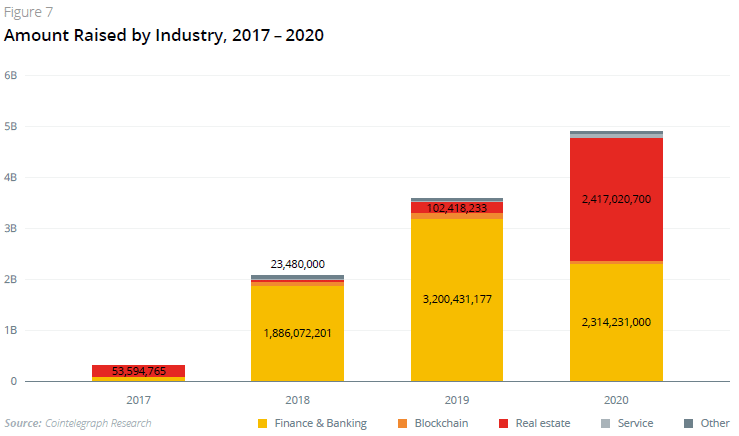
The amount of funds raised via securities continuously increased between 2017 and 2020. Considering 2020, 80 tokenizations were realised and a total of 4.8 billion USD was received in fundraising. These funds came almost exclusively from the finance and banking and real estate sectors. We see that the real estate sector (coloured in red) was on the offensive especially in 2020. This rise occurred as a result of the tokenization of 2.2 billion USD in real estate by the American real estate company Red Swan through Polymath. Another example among the largest tokenization actions in 2020 was the tokenization of 1.6 billion USD in government savings bonds by the Bank of Thailand.
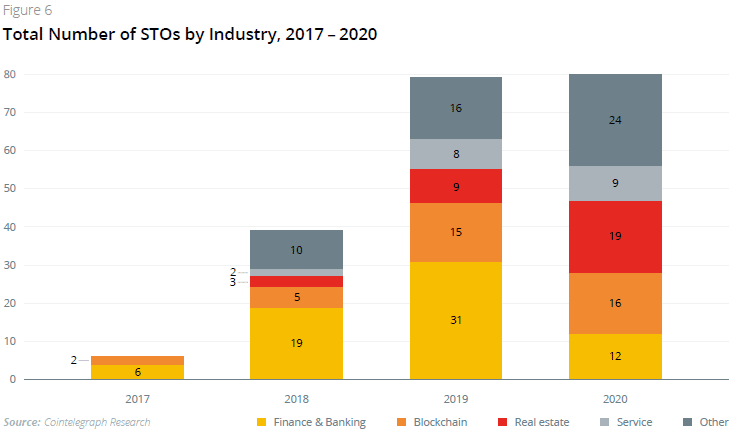
Considering the same statistics from a quantitative perspective, we see that the largest increase in 2020 was in the real estate sector coloured in red. The banking and finance sector saw the largest decrease in the same period. Moreover, there was also an increase in the ‘Other’ category at the top coloured in dark grey. Considering the Other sector specifically, we can predict that various other sectors attempted tokenization innovations.
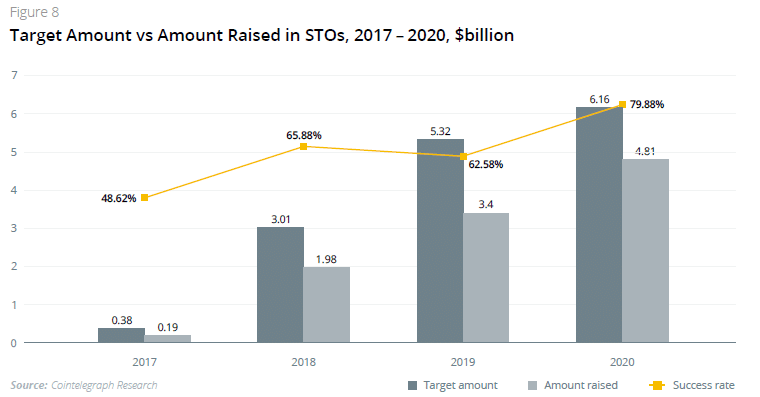
The graph above which illustrates the amount of funds the companies that performed tokenization aimed to raise and the amount of funds they did raise shows the general success rate of tokenization. With the success rate rising to 79.88% in 2020, we can conclude that companies reached their fundraising targets to a great extent. The graph above is quite important in terms of the maturation of the market.
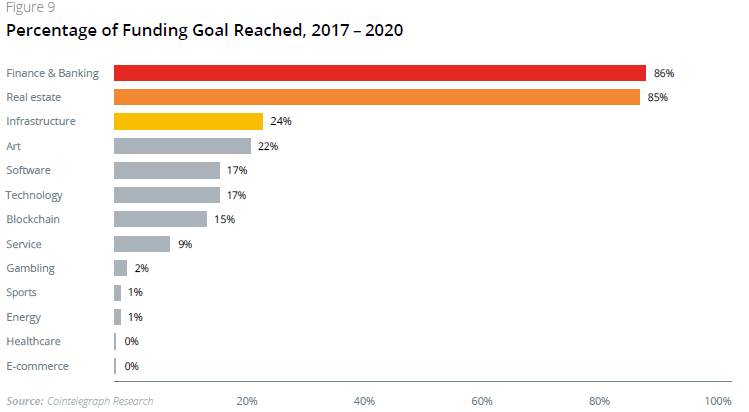
When the success rate is classified according to sectors, the view considerably changes. We see that the tokenizations that reached their targets belonged almost exclusively to the categories of finance and banking and real estate. The tokenization success rates in the remaining infrastructure, software and art fields seem quite low. Though there is a supply of tokenization in various fields in the market, we can say that investors focus on specific fields.
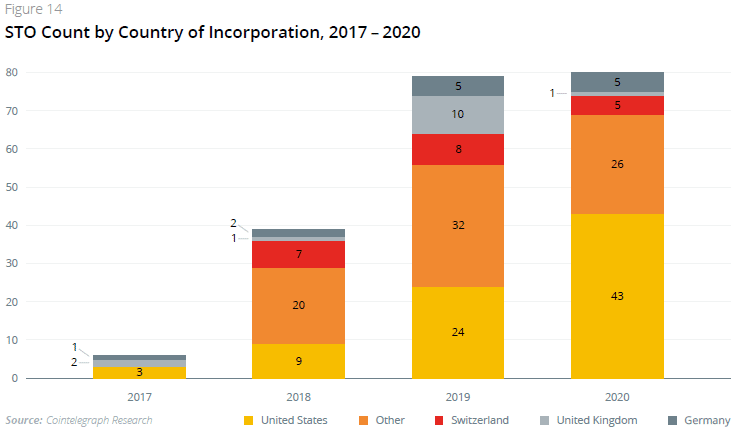
In the graph above where security tokens are classified according to countries, we see that American investors made important moves in 2020 and dominated the market. The ‘Other’ sector having the second largest share can be interpreted as institutions from other countries experimenting with tokenization. Besides this, Switzerland and the United Kingdom occasionally make important moves as well.
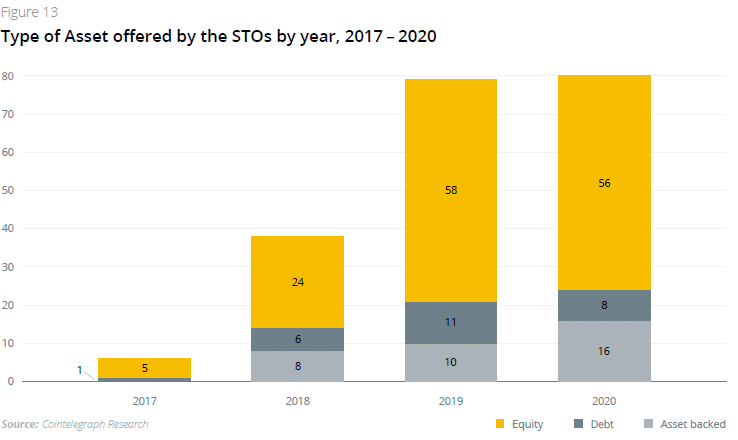
The graph above where securities are classified according to their types shows the ‘equity’ category coloured in yellow trumps others irrespective of the year. This clearly shows that companies often resort to security tokens to grow their equities. There was also an increase in the number of asset-backed tokens thanks to the real estate sector.
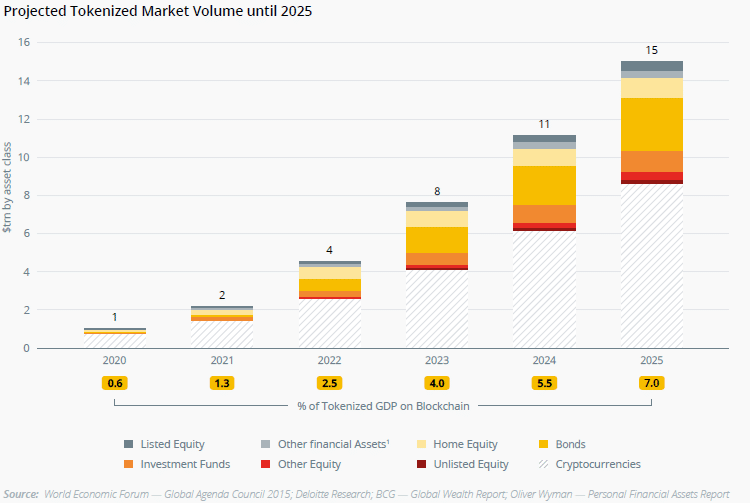
Finally, it is expected that the total volume of security tokens will exceed 15 trillion USD in 2025 together with cryptocurrencies. We see that in this volume expectation, the volumes of cryptocurrencies and securities share the expectation of 15 trillion USD almost half-and-half.
The aggressive stance of banks and regulators in this field give rise to expectations that a significant increase will occur in the sector until 2025.
The graphs and statistics in this report are obtained from ‘The Security Token Report’ of Cointelegraph Research. Click to access the original version of the report.
Written By: Berkay Aybey
The opinions and comments expressed here belong to BV Crypto. BV Crypto cannot be held responsible for any financial transactions made on the basis of this post. Every investment and trading move involves risk. When making your decision, you should do your own research.